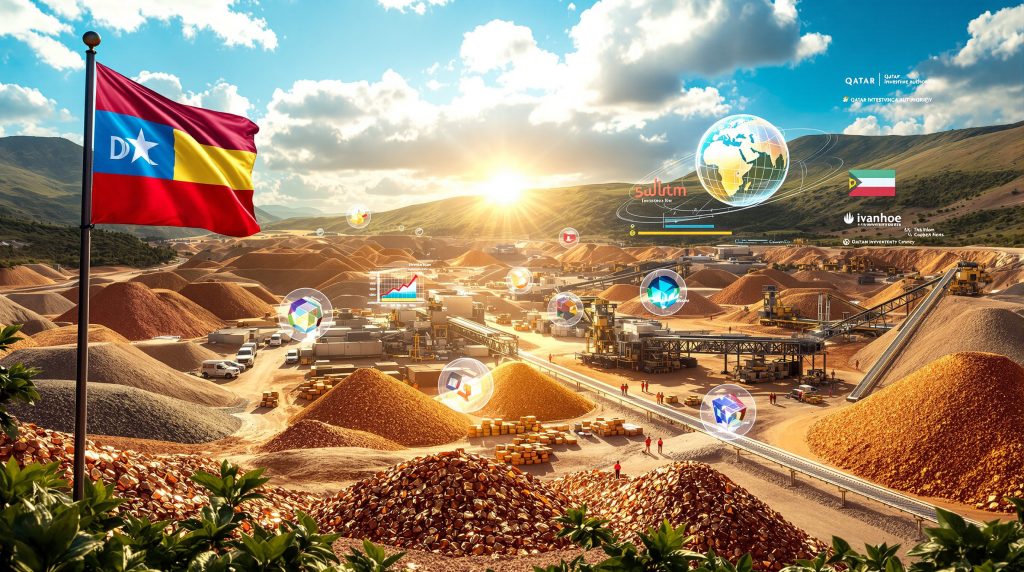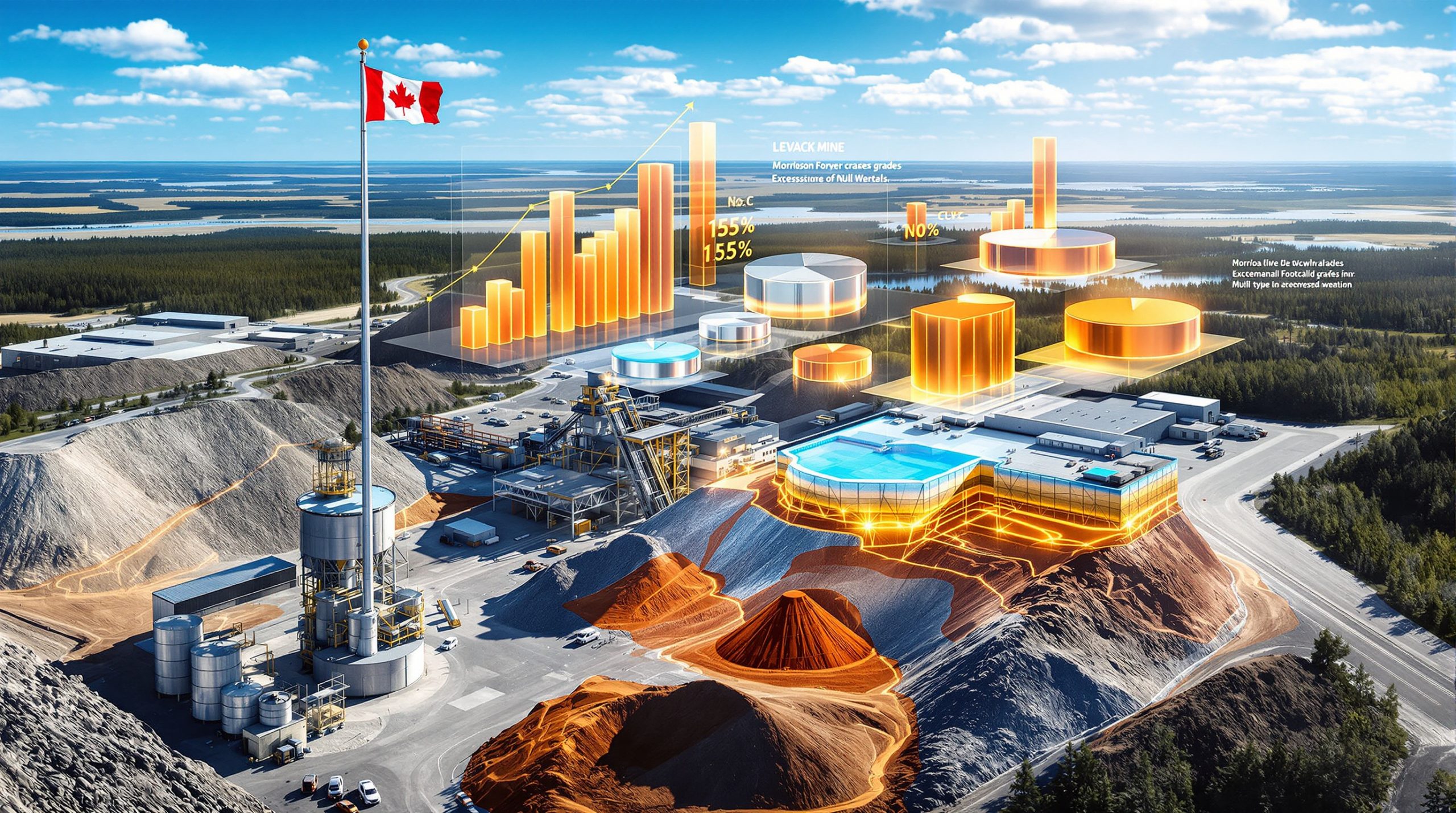How Institutional Capital Reshapes Global Supply Chain Architecture
The evolution of critical minerals energy transition markets reflects broader shifts in institutional investment philosophy, where traditional commodity speculation gives way to strategic supply chain positioning. Sovereign wealth funds increasingly recognise that controlling upstream production capabilities provides competitive advantages beyond pure financial returns, particularly as technology manufacturers face unprecedented demand for specialised materials.
This transformation stems from fundamental changes in global energy infrastructure requirements. Electric vehicle production, renewable energy installations, and data centre expansion create sustained demand for copper, cobalt, nickel, and platinum group metals. Unlike cyclical commodity markets driven by speculation, these technology-driven demand patterns offer institutional investors predictable, long-term growth trajectories that justify integrated supply chain investments.
What Makes Qatar Investment Authority's Mining Strategy Revolutionary?
Qatar Investment Authority's approach to critical minerals represents a paradigm shift in sovereign wealth fund investment strategies. Unlike traditional resource investments focused purely on financial returns, QIA's framework integrates geopolitical supply chain security with technological infrastructure development through strategic partnerships that prioritise vertical integration over portfolio diversification.
The $500 million strategic investment QIA committed to Ivanhoe Mines in September 2025 demonstrates this evolved approach. Rather than passive equity participation, the investment establishes collaborative frameworks for exploration, development, processing, and downstream capacity building across multiple jurisdictions. Furthermore, this Ivanhoe Qatar Investment Authority MoU creates a foundation for long-term strategic collaboration.
Sovereign Wealth Fund Evolution in Resource Sectors
Traditional sovereign wealth fund resource investments typically focused on:
- Portfolio diversification through commodity exposure
- Financial returns correlated to global commodity price cycles
- Limited operational involvement in mining operations
- Geographic concentration in established mining jurisdictions
- Short-to-medium-term investment horizons aligned with fund liquidity requirements
QIA's evolved model prioritises:
- Direct supply chain control reducing dependency on third-party suppliers
- Technology sector demand correlation rather than commodity price speculation
- Operational excellence through integrated infrastructure development
- Geographic diversification across emerging mining jurisdictions
- Long-term strategic positioning supporting Qatar's industrial development objectives
Critical Minerals as Strategic Assets
The designation of certain minerals as "critical" reflects their essential role in technology infrastructure rather than traditional industrial applications. This evolution in mining trends shows how cobalt, lithium, rare earth elements, and platinum group metals enable:
- Battery technology advancement: Electric vehicle adoption requires reliable cobalt and lithium supplies
- Renewable energy infrastructure: Wind turbines and solar installations demand significant copper and rare earth inputs
- Data centre expansion: Artificial intelligence and cloud computing infrastructure require specialised electrical components containing platinum group metals
- Grid modernisation: Smart grid technology depends on copper and rare earth permanent magnets
Supply chain vulnerabilities emerge from geographic concentration of production. The Democratic Republic of Congo produces approximately 50% of global cobalt supply, while China controls over 70% of rare earth processing capacity. This concentration creates systemic risks for technology manufacturers requiring diverse, reliable supply sources.
How Does the Memorandum of Understanding Structure Future Collaboration?
The partnership framework extends beyond conventional mining investment models, establishing multiple collaboration vectors across the critical minerals value chain. The MoU creates preferential access to QIA's extensive financial networks while enabling operational integration across exploration, development, and processing activities.
Financial Infrastructure Development
The collaboration establishes sophisticated financing mechanisms that leverage QIA's institutional relationships:
- Preferential financing access: QIA's network provides favourable financing terms for African mining projects through established relationships with international financial institutions
- Risk-sharing frameworks: Joint investment structures distribute exploration and development risks across institutional partners
- Capital deployment strategies: Coordinated funding across project lifecycles from exploration through commercial production
- Infrastructure financing: Direct investment in power, water, and transportation infrastructure supporting mining operations
Operational Integration Opportunities
The partnership enables vertical integration across critical minerals value chains:
- Downstream processing capacity development: Joint investment in smelting and refining facilities
- Infrastructure coordination: Integrated planning for logistics, power generation, and water resources
- Technology transfer mechanisms: Sharing advanced mining and processing technologies across projects
- Operational excellence standardisation: Implementing consistent environmental, social, and governance practices
Strategic Merger and Acquisition Framework
The MoU establishes collaboration frameworks for market consolidation:
- Portfolio optimisation: Identifying acquisition targets that complement existing operations
- Market positioning: Strategic acquisitions strengthening competitive position in critical minerals supply
- Regional expansion: Coordinated M&A activities across target jurisdictions including Angola, Kazakhstan, and Zambia
Why Are Democratic Republic of Congo Operations Central to This Alliance?
The DRC's mineral endowment positions it as fundamental to global technology supply chains, making Qatar's investment timing strategically significant. DRC mineral reserves include world's largest cobalt deposits (approximately 3.6 million tonnes representing 50% of global reserves) and substantial copper resources supporting multiple world-class mining operations.
Western Forelands Project Significance
The Western Forelands exploration project covers area over six times larger than the adjacent Kamoa-Kakula Copper Complex, indicating substantial resource potential. Exploration licences in the Makoko district target sedimentary copper deposits similar to those successfully developed at Kamoa-Kakula, suggesting geological continuity across the broader region.
Resource scale projections, while preliminary, indicate potential for multiple mine developments across the Western Forelands tenure. The proximity to existing Kamoa-Kakula infrastructure provides cost advantages for future development through shared processing facilities, power infrastructure, and transportation networks.
Development timeline projections extend across multiple phases:
- 2025-2027: Exploration acceleration and resource definition
- 2027-2030: Feasibility studies and mine development decisions
- 2030+: Commercial production from priority deposits
Infrastructure requirements for large-scale development include power supply expansion, transportation capacity enhancement, and processing facility construction. However, the integrated approach enables coordinated infrastructure development across multiple projects rather than duplicative facility construction.
Geopolitical Context and Bilateral Relations
The strategic timing of the Ivanhoe Qatar Investment Authority MoU signing coincided with high-level diplomatic engagement between Qatar and the DRC. According to Forbes Middle East, Amir of Qatar Sheikh Tamim bin Hamad Al-Thani's visit to meet with DRC President Félix Tshisekedi specifically addressed bilateral relations strengthening, validating the partnership's geopolitical significance.
This diplomatic foundation provides regulatory certainty for long-term mining investments. Bilateral trade agreements and investment protection frameworks reduce political risk exposure while establishing preferential access to DRC mineral resources for Qatari strategic objectives.
Regional stability considerations influence long-term operational planning. The partnership's multi-country approach across DRC, Angola, Kazakhstan, and Zambia distributes geopolitical risks while maintaining operational flexibility across different regulatory environments.
What Investment Metrics Define Success in Critical Minerals Partnerships?
Critical minerals investment success requires multidimensional evaluation frameworks that extend beyond traditional commodity investment metrics. The QIA-Ivanhoe partnership demonstrates sophisticated approaches to risk assessment, return calculation, and strategic value creation through implementing a comprehensive critical minerals strategy.
| Investment Vector | Traditional Approach | QIA-Ivanhoe Model | Strategic Advantage |
|---|---|---|---|
| Capital Deployment | Project-specific funding | Integrated value chain | Risk distribution across projects |
| Geographic Focus | Single jurisdiction | Multi-country portfolio | Political risk diversification |
| Technology Integration | Limited involvement | Full value chain control | Operational cost optimisation |
| Infrastructure Development | Third-party reliance | Direct investment | Supply chain security |
| Market Positioning | Commodity price exposure | Technology demand correlation | Demand stability |
Return on Investment Calculations
Traditional mining investment metrics focus on:
- Net Present Value (NPV): Discounted cash flows based on long-term commodity price assumptions
- Internal Rate of Return (IRR): Project returns relative to required rates of return
- Payback period: Capital recovery timelines under various operational scenarios
- Sensitivity analysis: Performance under different commodity price, cost, and production assumptions
The integrated partnership model requires additional success metrics:
- Supply chain security value: Quantifying benefits of reliable mineral supplies to technology sectors
- Infrastructure optimisation returns: Cost savings through shared facilities and coordinated development
- Technology transfer benefits: Operational improvements through advanced mining and processing techniques
- Market positioning advantages: Premium pricing for certified, responsibly-sourced critical minerals
Long-term commodity price projections incorporate technology sector demand growth modelling rather than cyclical commodity price patterns. Electric vehicle adoption, renewable energy deployment, and data infrastructure expansion create sustained demand growth trajectories supporting premium pricing for reliable suppliers.
How Will This Partnership Impact Global Critical Minerals Markets?
The QIA-Ivanhoe alliance represents broader institutional investment trends toward vertical integration in critical minerals supply chains. This model influences competitive dynamics, pricing structures, and supply chain resilience across global markets, particularly when combined with effective copper investment strategies.
Supply Chain Resilience Enhancement
Geographic diversification of critical mineral sources reduces systemic risks:
- Reduced single-country dependency: Multi-jurisdiction operations across DRC, Angola, Kazakhstan, and Zambia distribute political risks
- Supply chain buffering capacity: Integrated ownership enables strategic stockpiling and market stabilisation
- Alternative processing routes: Downstream capacity development reduces dependence on Chinese processing dominance
Strategic reserve development capabilities provide market stabilisation functions during supply disruptions. Unlike traditional commodity markets where supply interruptions create price volatility, integrated supply chains enable buffer stock management supporting stable pricing for technology manufacturers.
Technology Sector Implications
Technology manufacturers increasingly prioritise supply chain security over cost optimisation:
- Electric vehicle manufacturing: Reliable battery material supplies enable production planning certainty
- Data centre infrastructure: Consistent mineral supplies support rapid infrastructure deployment
- Renewable energy technology: Stable material costs improve renewable energy project economics
Global EV Market Context: Electric vehicle sales reached approximately 13.6 million units in 2024, with projections indicating continued growth through 2030. Each EV battery requires approximately 60-100 kg of copper, 20-30 kg of nickel, and 15-20 kg of cobalt, creating substantial mineral demand growth.
Data Centre Expansion: Global data centre power consumption increases drive infrastructure mineral demand. Power distribution systems, cooling infrastructure, and electrical components require copper, nickel, and platinum group metals in quantities that grow proportionally with computing capacity expansion.
Competitive Landscape Shifts
Market consolidation through strategic partnerships creates competitive advantages:
- Integrated supply chain control: Vertical integration from mining through processing provides cost advantages
- Technology advancement capabilities: Coordinated research and development across operations enables innovation
- Customer relationship management: Direct relationships with technology manufacturers enable long-term supply contracts
- Regulatory compliance leadership: Consistent environmental and social standards across operations support responsible sourcing certification
New player emergence in critical minerals space reflects broader recognition of strategic value. Technology companies, sovereign wealth funds, and institutional investors increasingly enter mining sector investments directly rather than through commodity trading or financial instruments.
What Are the Operational Excellence Factors for Success?
Successful critical minerals partnerships require sophisticated approaches to environmental stewardship, community engagement, and technological innovation that exceed traditional mining industry standards. Furthermore, incorporating AI in mining technology enhances operational efficiency significantly.
Environmental, Social, and Governance Integration
ESG considerations for critical minerals operations reflect heightened scrutiny from technology sector customers:
- Sustainable mining practices: Advanced extraction techniques minimising environmental impact
- Community benefit-sharing models: Revenue distribution supporting local economic development
- Water resource management: Advanced treatment and recycling systems protecting local water supplies
- Biodiversity protection: Conservation programmes maintaining ecological integrity around mining operations
Carbon footprint reduction initiatives align with technology sector sustainability commitments. Electric vehicle and renewable energy manufacturers require low-carbon mineral supplies to support their environmental objectives, creating premium pricing opportunities for certified sustainable operations.
Technology and Innovation Deployment
Advanced mining technologies enable operational excellence:
- Automated extraction systems: Robotics and artificial intelligence improving safety and efficiency
- Digital twin modelling: Virtual operation optimisation reducing costs and environmental impact
- Real-time monitoring: IoT sensors enabling predictive maintenance and operational optimisation
- Advanced metallurgy: Innovative processing techniques improving recovery rates and reducing waste
Research and development collaboration frameworks leverage QIA's network for technology advancement. Partnership with international research institutions and technology companies accelerates innovation adoption across mining operations.
How Does This Model Scale Across Other Resource Partnerships?
The QIA-Ivanhoe framework provides templates for sophisticated sovereign wealth fund approaches to strategic resource investments. This model's success influences broader institutional investment strategies in critical minerals and other strategic resources.
Replication Framework for Other Sovereign Wealth Funds
Partnership structure templates include:
- Risk assessment methodologies: Comprehensive evaluation frameworks for political, operational, and market risks
- Success metrics definition: Balanced scorecards incorporating financial and strategic objectives
- Governance frameworks: Joint decision-making structures balancing investor and operator perspectives
- Exit strategy planning: Flexible approaches to investment realisation based on strategic objectives achievement
Performance indicators encompass both quantitative and qualitative measures:
- Financial performance: Traditional mining investment metrics adapted for strategic partnerships
- Supply chain security: Reliability metrics for mineral supply delivery
- Technology advancement: Innovation adoption and operational improvement measures
- Sustainability achievement: Environmental and social impact indicators
Regional Expansion Opportunities
The partnership model enables expansion across multiple jurisdictions:
- Angola: Sedimentary copper exploration opportunities in geological formations similar to Kamoa-Kakula
- Kazakhstan: Diversified mineral resources including copper, uranium, and rare earth elements
- Zambia: Established mining infrastructure supporting copper and cobalt development
Infrastructure development requirements vary across regions but benefit from coordinated planning:
- Power supply: Regional grid integration and renewable energy development
- Transportation networks: Rail, road, and port infrastructure supporting mineral exports
- Processing facilities: Strategic placement of smelting and refining capacity
- Water resources: Comprehensive management across multiple operations
Regulatory harmonisation needs include standardised environmental standards, community engagement protocols, and technical safety requirements across operations in different jurisdictions.
What Timeline Considerations Shape Partnership Implementation?
Strategic partnership implementation requires coordinated planning across multiple project development phases. The Ivanhoe Qatar Investment Authority MoU timeline reflects realistic development schedules for large-scale mining operations while maintaining flexibility for market opportunity adaptation.
Short-term Milestones (2025-2027)
Western Forelands Exploration Acceleration:
- Exploration drilling programme expansion across priority targets
- Resource estimation and geological modelling completion
- Environmental baseline studies and impact assessments
- Community engagement and benefit-sharing negotiations
Infrastructure Development Initiation:
- Power supply expansion planning for future operations
- Transportation corridor evaluation and enhancement
- Water resource management system design
- Processing facility site selection and preliminary design
Regulatory Framework Establishment:
- Mining licence applications and approvals
- Environmental impact assessment completion
- Community development agreement finalisation
- International certification programme enrollment
Medium-term Objectives (2027-2030)
Production Capacity Scaling:
- Mine development construction at priority Western Forelands deposits
- Processing facility construction and commissioning
- Transportation infrastructure completion
- Workforce development and training programme implementation
Downstream Processing Facility Development:
- Smelting and refining capacity construction
- Technology integration and optimisation
- Quality control and certification system establishment
- Customer relationship development with technology manufacturers
Market Positioning Consolidation:
- Long-term supply contract negotiation with key customers
- Strategic acquisition evaluation and execution
- Regional operation integration and optimisation
- Technology advancement through research and development collaboration
Long-term Strategic Goals (2030+)
Global Supply Chain Integration:
- Multi-jurisdiction operation coordination across DRC, Angola, Kazakhstan, and Zambia
- Integrated processing network optimisation
- Customer relationship management across global technology sectors
- Strategic stockpiling and market stabilisation capabilities
Technology Leadership Establishment:
- Advanced mining technology deployment across operations
- Research and development centre development
- Innovation partnership with technology companies and research institutions
- Intellectual property development in critical minerals processing
Sustainable Development Model Replication:
- Environmental standard leadership across global mining industry
- Community development programme expansion
- Responsible sourcing certification achievement
- ESG performance benchmark establishment for critical minerals sector
The Qatar Investment Authority-Ivanhoe Mines partnership demonstrates sophisticated approaches to critical minerals investment that integrate financial returns with strategic supply chain positioning. As detailed in this comprehensive analysis from Mining.com, this model illustrates how institutional investors can leverage capital and networks to create competitive advantages in technology-critical resource sectors.
Success of this partnership will likely influence institutional investor approaches to critical minerals investments, potentially reshaping global resource investment landscapes toward integrated, strategic models that prioritise long-term supply chain security alongside financial returns. Consequently, the framework provides templates for similar partnerships while demonstrating the evolution of sovereign wealth fund investment strategies toward strategic asset control rather than passive portfolio diversification.
Looking to Capitalise on Critical Minerals Investment Opportunities?
Discovery Alert's proprietary Discovery IQ model delivers real-time alerts on significant ASX mineral discoveries, instantly empowering subscribers to identify actionable opportunities ahead of the broader market. Understand why major mineral discoveries can lead to substantial returns by exploring historic examples of exceptional outcomes, then begin your 30-day free trial today to position yourself ahead of the market.




